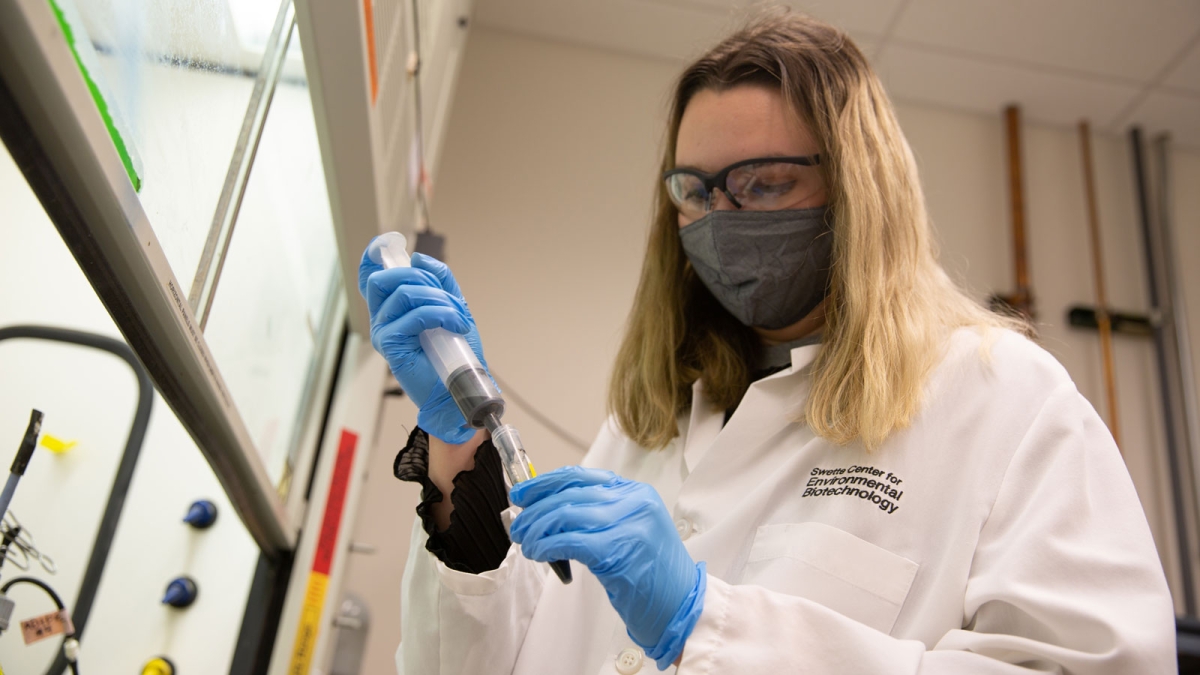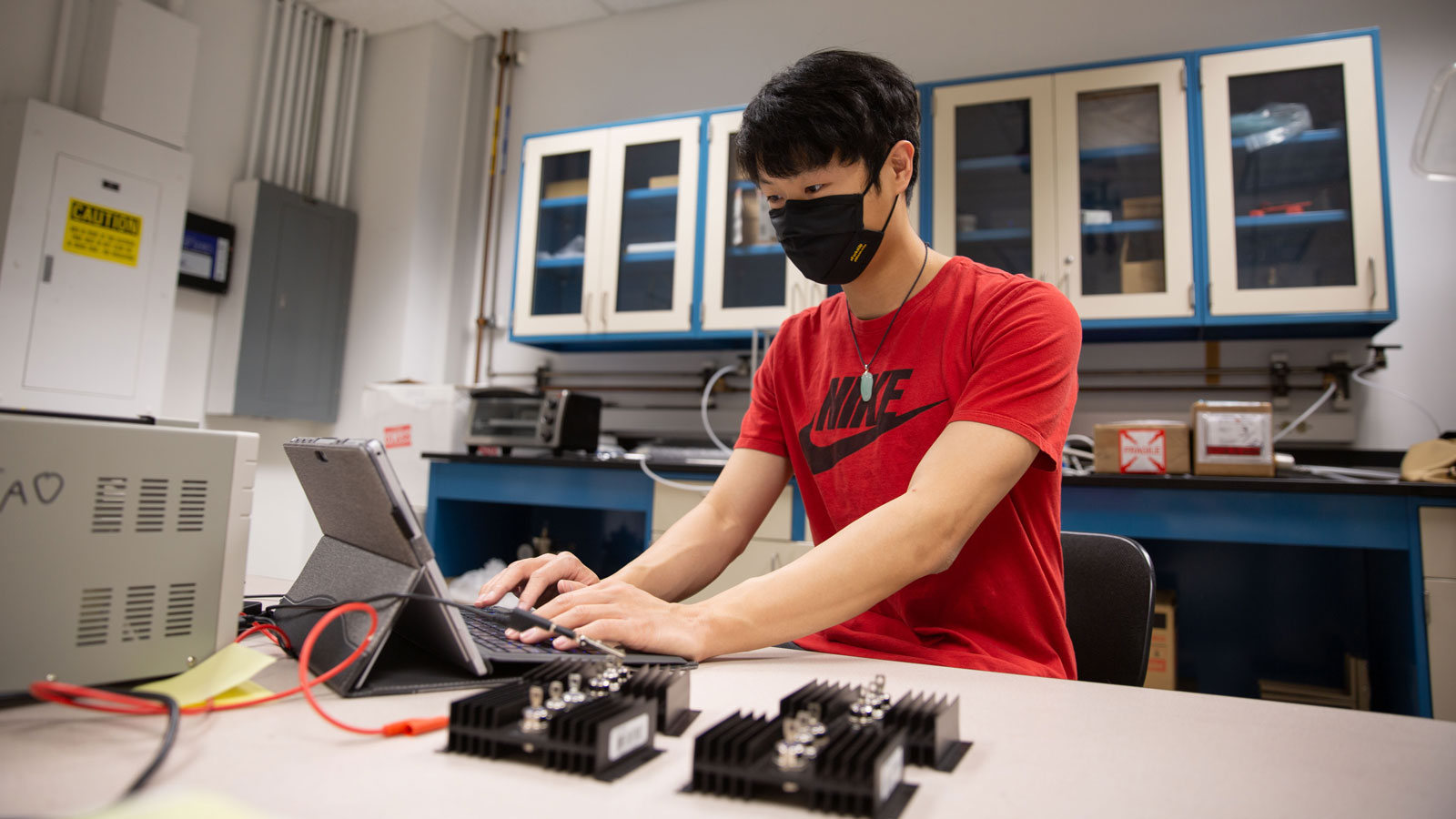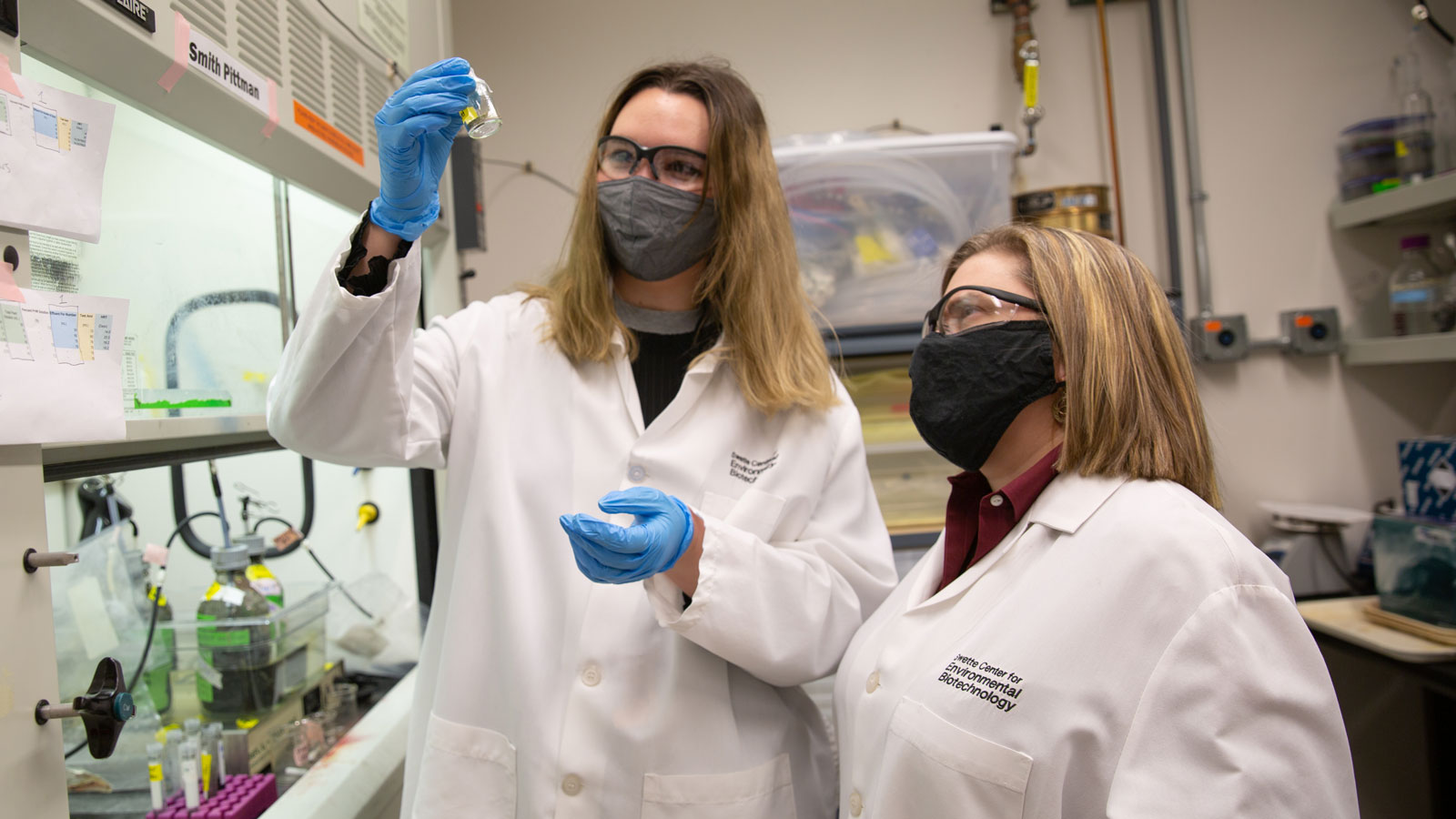ASU engineering students tackle real-world challenges

Arizona State University engineering students, like environmental engineering junior Smith Pittman, conduct innovative research each semester under the guidance of a faculty mentor. They present their research findings related to real-world challenges in health, sustainability, energy, security, education and data science at the FURI/MORE symposium, held virtually this semester in a poster session open to the public. Photo by Erika Gronek/ASU
Improving solar power load management systems, turning waste into valuable products and teaching robotic swarms to coordinate are just a few of the areas students in the Ira A. Fulton Schools of Engineering at Arizona State University are researching to gain new ways of thinking.
Conducting research is an excellent way for students to understand how the theoretical knowledge they learn in engineering classes relates to real-world applications. Students can also make an impact in people’s lives with the innovative solutions yielded by scientific research they conduct — even before they start their careers.
There are multiple opportunities for undergraduate and graduate students in the Fulton Schools to address challenges in data science, education, energy, health, security and sustainability.
Students in the Fulton Undergraduate Research Initiative, or FURI, and the Master’s Opportunity for Research in Engineering, or MORE, programs conceptualize an idea, develop a plan and investigate their research question with a faculty mentor over the course of a semester.
Fulton Schools students in the Grand Challenges Scholars Program, or GCSP, can also conduct research for one of the competencies required by the program.
All three opportunities develop students’ skills in innovation, independent thinking and problem-solving to support their future pursuits and careers. And all are invited to participate in the FURI/MORE symposium, an event near the end of each semester in which students present their research findings in a poster session.
Learn about four Fulton Schools students and one faculty mentor participating in the spring 2021 FURI/MORE virtual symposium. Meet these students and more than 110 other student investigators at the virtual event, open to the public from 1 to 3 p.m. MST, Friday, April 16.

Kelvin Tan, an electrical engineering senior, is working on a FURI research project to improve photovoltaic load management systems through the development of a new, efficient algorithm. He conducts research in Professor Meng Tao’s lab. Photo by Erika Gronek/ASU
Designing new algorithms for solar power
Kelvin Tan is an electrical engineering senior in the FURI program. He is developing an efficient algorithm for load management to accelerate the development of photovoltaics for the energy sector with his mentor, Professor Meng Tao.
Question: What made you want to get involved in FURI?
Answer: My aspiration to get involved in this program was to explore and evaluate my future decisions as a graduate student. I have always wanted to make an impact in the sustainability movement and this was a great opportunity for me to see which sector I should dedicate myself to — either research or industry. The project and this program was the perfect opportunity for me to involve myself in research that quickly answered my uncertainty from before.
Q: Why did you choose the project you’re working on?
A: Research on renewable systems, like solar, is a great way for me to be as impactful as possible for the clean energy movement. Designing and improving the technology to increase the incentives will drive the integration of clean energy. The project I am working on directly relates to this.
Q: What has been your most memorable experience as a student researcher in this program?
A: My most memorable experience as a student researcher would have to be when my professor requested that I publish a paper for the 48th IEEE Photovoltaic Specialists Conference. Professor Meng Tao put me in an open-ended project where I could choose how much and what direction I planned to take in the project. This really pushed me to learn about the system and to make the project my own. After a lot of dedication, I felt that my work is on par with my colleagues and I am doing impactful research.
Q: Have there been any surprises in your research?
A: There have been many surprises in my research. For all of the variables I analyze, I will always have an educated guess on what the results are going to be. As the project escalated and I got to look more into sophisticated processes, these results began to be unpredictable at times. They were always welcome surprises.
Q: How will your engineering research project impact the world?
A: My research project will increase the opportunities in solar photovoltaic systems. The proposed system will be able to reduce the overall cost while increasing the efficiency of direct-coupled photovoltaics. Promoting renewables and energy storage is the gateway to a sustainable future. There are many roadblocks to clean technology. The goal of this project is to eliminate these obstacles and pave the way for a future society powered by clean energy.
Q: What is the best advice you’ve gotten from your faculty mentor?
A: Take a step back and organize my efforts. I have a habit of rushing through all of my tasks as most academic projects have directions and end goals with just enough time in between the two. My faculty mentor made me truly analyze the basics and take a procedural approach to everything. In the end, this approach saved more time and will help improve the quality of my research findings.
Q: Why should other students get involved in FURI?
A: There are so many opportunities in engineering today, and I feel as if most students will never be able to experience everything before they enter the industry. This program will help students better understand the different pathways out there and allow us to make decisions without regret. The experience and mentorship are things that cannot be taught in classes and so this is definitely an experience I would advise students to take.
FURI has been very impactful for me as a senior, but I would have liked to have experienced it earlier in my degree program. I appreciate the opportunity because I had trouble finding an activity I was passionate about until I joined the FURI program under Professor Tao.
Read more about Tan’s spring 2021 research project.

Environmental engineering major Smith Pittman (left) works with Assistant Research Scientist Michelle Young on a project to use waste biomass from industrial processes to produce valuable products. Pittman, who is conducting research as part of the Grand Challenges Scholars Program, also worked with faculty mentor Regents Professor Bruce Rittmann. Photo by Erika Gronek/ASU
Transforming one industry's waste into another's product
Smith Pittman is an environmental engineering junior in the Grand Challenges Scholars Program. For the research or talent competency of the GCSP, she conducted research with Regents Professor Bruce Rittmann and Assistant Research Scientist Michelle Young to study whether cellulose predigested by microbes can recover valuable products from anaerobic digesters at wastewater facilities.
Question: What made you want to get involved in the Grand Challenges Scholars Program?
Answer: I wanted to get involved with GCSP because as an engineer it is really important to understand the social impacts of the work you do.
Q: Why did you choose the project you’re presenting at the FURI Symposium?
A: This is a relatively novel research topic, and so I think there will be potential for continued research after this project.
Q: How will your engineering research project impact the world?
A: Lignocellulose is an abundant untapped resource, as it is mainly considered waste biomass from industrial processes. Finding ways to degrade it, and thereby produce valuable products, will create more sustainable processes.
In general, my mentor and I have been pleasantly surprised with the results we are getting from the experiment.
Q: What has been your most memorable experience as a student researcher?
A: This is a little gross, but sometimes when feeding the reactors, which take waste materials and turn them into valuable byproducts, they will spit sludge back up. The first time this happened I was not prepared and it got everywhere. I was later able to figure out that it was due to gas buildup, and I could prevent this from happening by keeping the gas bags attached.
Q: How do you see this experience helping with your career or advanced degree goals?
A: I would like to continue researching, so I am looking at graduate schools. This experience has been incredibly helpful for me because it has helped me find something that I enjoy.
Q: What is the best advice you’ve gotten from your faculty mentor?
A: My mentor has really encouraged me to pursue my interests, which has helped me inside and outside the research lab.
I am very grateful for the support I receive from Dr. (Bruce) Rittmann, Dr. Michelle Young and GCSP.
Q: Why should other students get involved in GCSP?
A: GCSP is a wonderful program for students who want to have a positive impact on the world around them, and want to know about the future of engineering. I think students should also get involved in undergraduate research because it helps you to understand the application of what you are learning in your classes.
Learn more about Pittman’s spring 2021 research project.

Computer science graduate student Parth Khopkar studies multirobot swarms in the Master’s Opportunity for Research in Engineering program, known as MORE, with his mentor, Assistant Professor Heni Ben Amor. Photo by Erika Gronek/ASU
Helping robots learn to coordinate
Parth Khopkar is a computer science graduate student in the MORE program, which presents at the FURI symposium. Khopkar is teaching multirobot swarms to better coordinate using reinforcement learning techniques. He was inspired by search and rescue officials saying how this sort of technology could help them better perform their jobs.
Question: What made you want to get involved in MORE?
Answer: A couple of my friends were a part of MORE in previous semesters. When I attended their poster presentations at the symposium, I realized that this is something I would love to be a part of.
Q: Why did you choose the project you’re working on?
A: I have always been fascinated by the promise of robots working together in the future, similar to how humans do now. Coordination with fellow human beings has been the bedrock of human society since the earliest times. This is why I decided to focus on a project in the field of multirobot coordination.
Another inspiration for my project was an event held at ASU’s Drone Studio in January 2020 where officials from the Arizona Search and Rescue Coordinators Association talked about how having unmanned aerial vehicles (UAVs) in the loop would enable them to get feedback immediately during search and rescue operations and cover more ground than humans can.
Q: What has been your most memorable experience as a student researcher?
A: One of my most memorable experiences has been presenting in last semester’s symposium. Because it was virtual, my friends and family halfway across the world were also able to attend.
Q: How will your engineering research project impact the world?
A: My research on multirobot coordination has a chance to impact many aspects of the world we live in, from underwater robotics to planetary exploration. Something a little closer to home is the use of drones in autonomous search and rescue missions.
Q: How do you see this experience helping with your goals?
A: The research I do for MORE is also a part of my master’s thesis, so it is already helping my career by supporting my research interests.
Q: What is the best advice you’ve gotten from your mentor, Assistant Professor Heni Ben Amor?
A: My mentor always says that if you can’t get something to work, just keep reducing the complexity until it does. I have applied this to my work and found that the reduced complexity allows me to better understand the techniques being used and then scale up from there.
Q: Why should other students get involved in MORE?
A: If you are interested in research or want to know whether research is something that you would like to do for a career, this program is an excellent opportunity to gain research experience. Here, you set the bounds on what you would like to accomplish while being supported by a faculty mentor.
More Science and technology

Indigenous geneticists build unprecedented research community at ASU
When Krystal Tsosie (Diné) was an undergraduate at Arizona State University, there were no Indigenous faculty she could look to…

Pioneering professor of cultural evolution pens essays for leading academic journals
When Robert Boyd wrote his 1985 book “Culture and the Evolutionary Process,” cultural evolution was not considered a true…

Lucy's lasting legacy: Donald Johanson reflects on the discovery of a lifetime
Fifty years ago, in the dusty hills of Hadar, Ethiopia, a young paleoanthropologist, Donald Johanson, discovered what would…